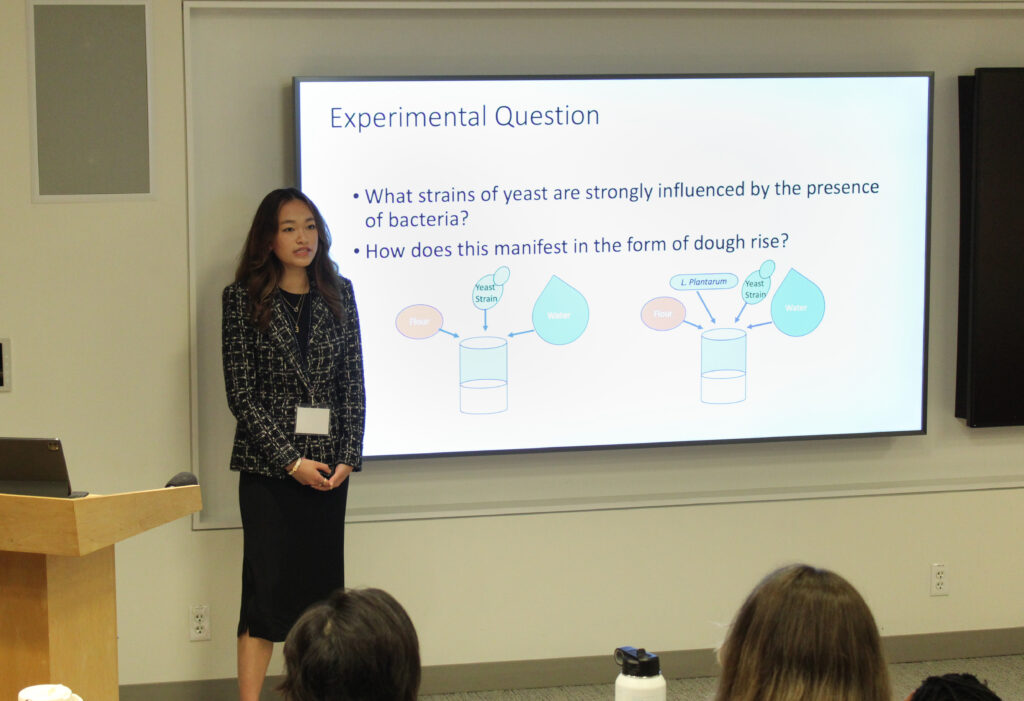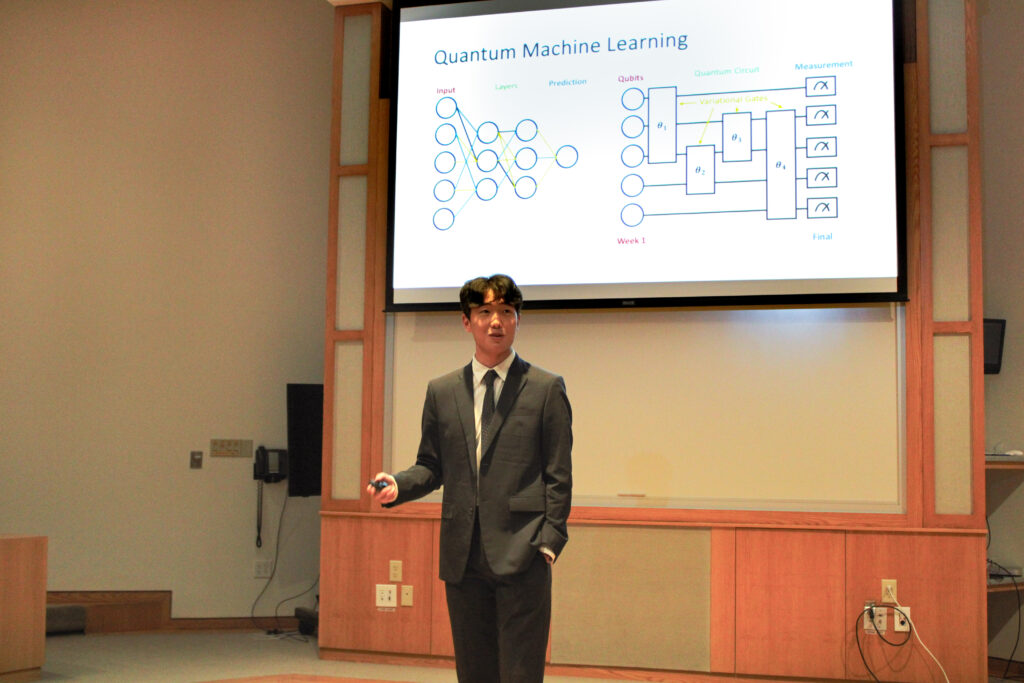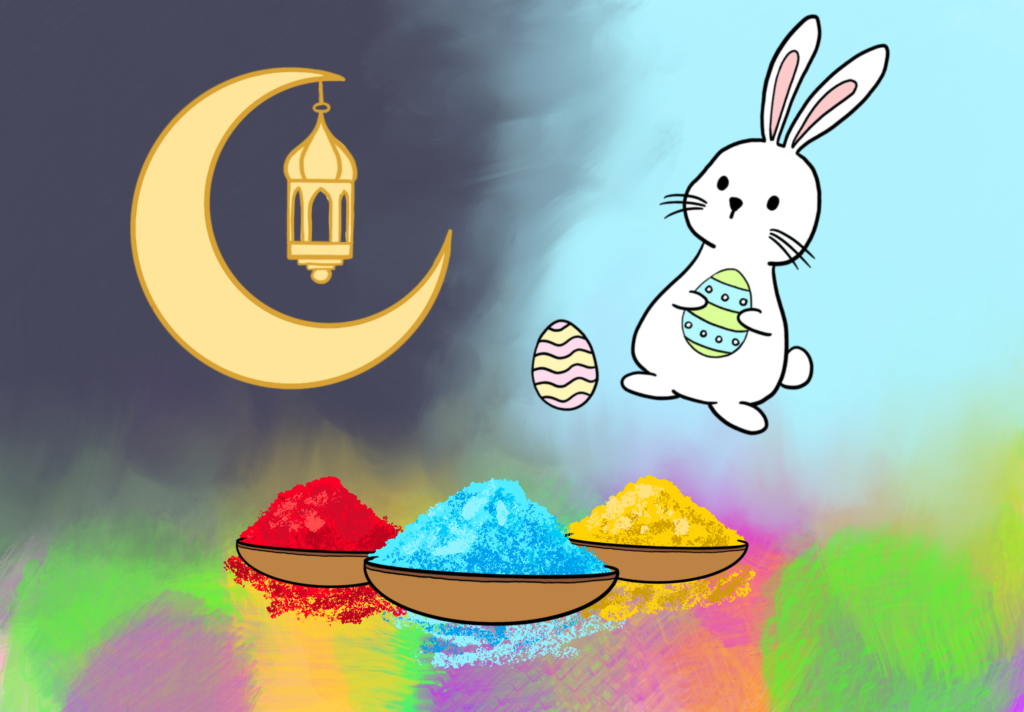
Erin Li ’24 presents on yeast genetic diversity in sourdough bread.

Danny Yoon ’24 presents on quantum computing.
By Teniola Obayomi ’25
Elman and Getz Auditoriums came alive on Tuesday, November 7, and Thursday, November 9, as students of the Science Research Program (SRP) presented at the annual Student Lecture Series (SLS). Each of the 16 student speakers delivered a 15-minute talk.
As one of the School’s eight Signature Programs, SRP provides an opportunity for students to explore and immerse themselves in the world of scientific research. The program consists of two cohorts, biological sciences and quantitative sciences, and spans four terms. Throughout their fifth-form year, students analyze scientific articles, strengthen their scientific writing skills, and gain experience with common laboratory techniques. The following summer, students work as interns in a lab of their choice, where they experience the day-to-day life of a research scientist. SRP culminates in the fall term of students’ sixth-form year, when students write a detailed research paper, create a professional poster, and present to the School about their learnings from their summer research experience.
The SLS presentations condences a summer’s worth of high-level research into a short lecture. According to SRP Co-Director Dr. Chris Hogue, student presenters must consider the knowledge of those listening when preparing their talk. “We really ask the students to think about who their audience is and to try to come up with connections to scientific topics, theories, concepts, and vocabulary that the audience knows.”
Amidst SLS preparations, sixth-form students reflected on their time in the SRP. Lorraine Hillgen-Santa ’24, a member of the biological sciences cohort, presented on the mechanosensation of the elephant-nose fish. Her earliest challenge in the SRP was understanding dense scientific literature. “The first article you read is always the hardest because you’re not at all fluent in scientific language. You’re not going to understand the style of writing until you repeatedly learn more and more.” She added, “I grew so much within SRP that it became so much easier over time.”
Despite the rigorous nature of SRP, participants made fond memories with their peers. Claire Liu ’24, another member of the biological sciences cohort, delivered a talk about a new genetic treatment for Rahman syndrome, a genetic syndrome with symptoms similar to Autism Spectrum Disorder.
Liu shared about the close relationships that she developed with her group. “I think one of the most memorable parts was being with my cohort and creating that bond, which I didn’t really expect going into it. It’s been such an amazing time. I’ve made so many new friendships through SRP,” she said.
Danny Yoon ’24, a member of the quantitative sciences cohort, presented on developing quantum computer algorithms. Over the course of the program, he also found himself growing close to his cohort. The group performed “The Scientist” by Coldplay to announce SLS at School Meeting on October 31. “We did a lot of science, but we also had fun doing music together. The fact that we put on that kind of performance in front of the whole school as an announcement for SLS meant a lot to our group,” he said.
As this sixth-form SRP group’s SRP experience comes to a close, Dr. Hogue hopes that students will transfer the skills they learned, whether it be working in a group, interacting with adults, or making professional deliverables, into whatever future careers they choose to pursue. He said, “Another goal is that even if they don’t go into science, they will always have an appreciation for what’s happening in the lab behind the scenes.”
Dr. Selena Gell, SRP Co-Director and leader of the biological science cohort, hopes that audiences are impressed with the students’ hard work: “They’re all doing things that are new. They’re at the cutting edge of science. Being prepared to do that kind of work takes a lot of preparation, in understanding the material, in learning the techniques, and thinking about how to do the experiment.” She explained that each lecture is more than a short talk, saying, “It really represents thousands of hours of preparation to get them to this time.”


